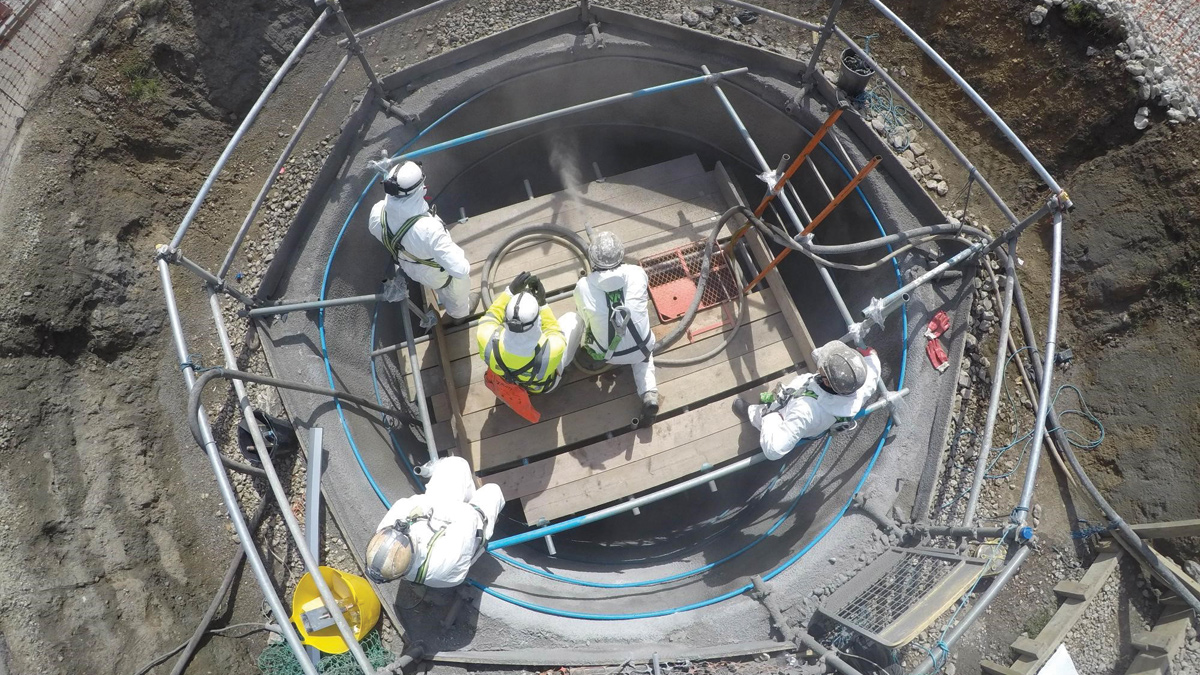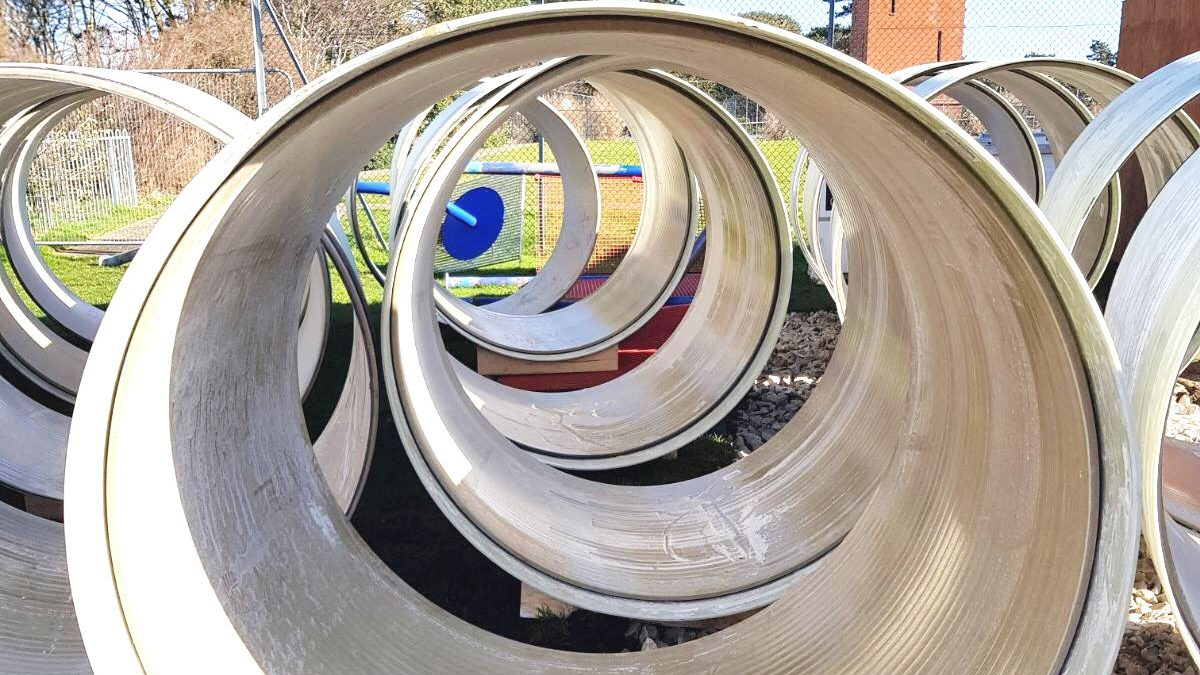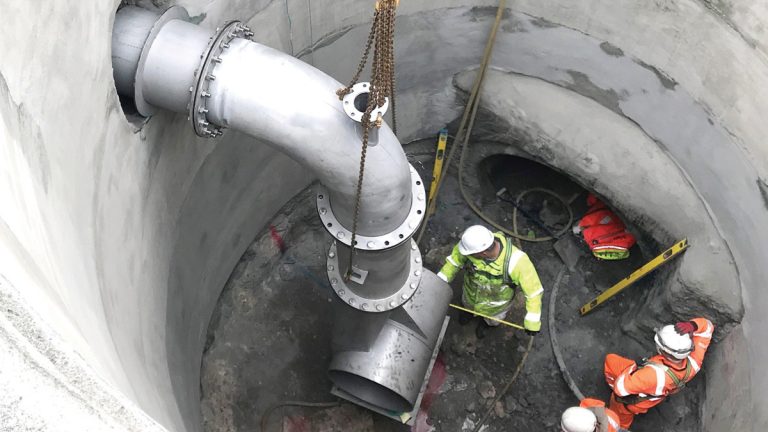Bournemouth CIS Tunnel Renovation (2018)

Dry shotcreting of the 40mm thick veneer of calcium aluminate cement over the base SRPC shaft wall - Courtesy of Wessex Water
Bournemouth is served by a sewerage tunnel known as the Coastal Interceptor Sewer (CIS), an inverted ‘T’ configuration with two tunnels routed parallel to the coastline and a few hundred metres inland. The two tunnels are routed towards each other and form a confluence equidistant along the coast, turning north and heading inland towards the Holdenhurst Sewage Recovery Works, located outside the main conurbation. Wessex Water has a survey programme of major assets, of which this is included. The CIS is 1.8m in diameter and constructed in compressed air from 1964-1971, with a primary bolted lining and a secondary cast in situ lining for hydraulic conductivity. The tunnel is a total of 8km in length and a recent survey of the tunnel has identified a noticeable change in the structural capabilities of the lining at the extremes of the eastern leg, close to shaft 13.
Introduction
The tunnel serves a cumulative population of 34,500 and receives a maximum flow rate of 600 l/s from two rising mains, the Hengistbury Head 500mm diameter and the Iford 400mm diameter mains. It is evident that the Iford rising mains is long, and has a reduced number of starts, resulting in the sewage resting quiescent for long periods. Consequently, anaerobic conditions allow the formation of hydrogen sulphide (H2S), which converts to sulphuric acid (H2SO4) via conversion associated with bacteria feeding upon the nutrients readily available. This in turn corrodes the concrete, a ubiquitous process observed across the world.
Petrographical analysis
A petrographical analysis was undertaken of cores taken through the tunnel lining, by ACS Testing and Sandbergs Consulting Engineer’s. The test was carried out in accordance with APG SR2 (2010) and ASTM C856-14. Once photographed, the samples were prepared from the internal surface of the tunnel lining through to variable depths where concrete conversion was expected. Longitudinal fluorescent resin impregnated thin sections were taken and inspected by a Zeiss petrographical photomicroscope to identify the distribution of porosity and evident micro cracking.
The concrete was identified with aspects of sulphate resisting Portland cement (SRPC) although none of the samples contained cement replacement materials or pozzolanic mineral additions by way of PFA or GGBS. Moisture had penetrated the total depth of the secondary lining leading to general recrystallisation of cement hydrates and leaching of portlandite.
The porosity enhancement resulting from leaching had often been offset by pore infilling with secondary ettringite.
Having computed this information with the UCS strength of the concrete and visual evidence of cavities in the lining, the tunnel was analysed over its length to establish the residual longevity under the existing geostatic and hydrostatic loading.
Over the 1900m of tunnel on the eastern leg under consideration, the 200m chainage downstream of shaft 13 was identified for lining as it had a residual lifespan of 5-15 years. The lining at the interface with shaft 13 had a calculated lifespan of just 2 years.
In addition, shaft 13 had suffered degradation due to the H2S attack; the constant aerosol atmosphere measured levels of H2S at peaks of 334ppm, and required scabbling back and repair.
GRP lining of the tunnel
To allow entry into the 200m of tunnel downstream of shaft 13, in order to line the sewer with structural GRP segments, a ‘million point cloud’ survey of the tunnel was compiled, and combined with a terrestrial survey above ground, to form a three dimensional model. The flows from the two rising mains required diversion to a new temporary shaft located next to the CIS downstream of the proposed lining terminus, through which the flows could be discharged, via a short heading.
The set out of the shaft was successful and the extrados of the shaft lining landed 12m below ground level, with a 50mm clearance to the springing level extrados of the original CIS primary lining. The shaft was underpinned during excavation in a very firm dense, dry Branksome sand geology with SPT’s of >50 N value at depth. The connection was completed through to the tunnel, by core drilling and the over pumping commissioned.
The GRP linings were designed to German standard DWA A143-2 (ATV-M 127) and the procurement tendered along with the main contract, awarded to Matt Durbin Associates Ltd, and linings supplied by Amiblu Norway AS, a merger between the former Amiantit and Hobas in 2017. The liners constituted 1600mm internal diameter GRP one-piece circular segments with in wall joints.

GRP 1600mm diameter linings from Amiblu Norway AS – Courtesy of Wessex Water
The design of lining in this case was undertaken by Dr Dec Downey of Trenchless Opportunities Ltd with assistance from Dr Bernard Falter of the Department of Civil Engineering, University of Applied Sciences, Münster, Germany. In the German design code DWA A143-2 (ATV-M 127), three host pipe states are differentiated:
- State I: For infiltration leaking sewers without cracks.
- State II: For sewers with longitudinal cracks but a stable soil tunnel system.
- State III: For cracked pipes with larger deformations and considerable risk of collapse in the near future.
For the Bournemouth tunnel, State III was appropriate for establishing the wall thickness under given loads, against a GRP long-term E modulus of 10,000N/mm2. Falter has written of the fully deteriorated comparisons with the American ASTM F1216 in his paper to the International Society for Trenchless Technology (ISTT) Toronto, Ontario Canada in March 2009.
Wessex Water fully intend to build on its experience of liner design by instigating comparative designs in future, utilising the alternative French ASTEE concepts, for non-circular tunnels.
The 42mm thick, segments were imported from Gdańsk, Poland, and were installed once the shaft cover slab was removed, over a two-week period during Easter 2018. The 450kg lining segments were winched home to close joints, and the annulus between the original secondary lining and GRP segments filled, in isolated bays of 20m length, with Pozament SPP3 in three lifts, using a cumulative 70 tonnes of mixed grout.
Bournemouth CIS Tunnel Renovation – Supply chain
- Client/designers: Wessex Water
- Consultant for calcium aluminate cement: Ibco Pty ltd
- Consultant of GRP lining design: Trenchless Opportunities Ltd
- Main contractor: Matt Durbin Associates Ltd
- Provision of GRP linings: Amiblu Norway AS
- Provision of calcium aluminate cement: Sewpercoat
Renovation of shaft 13 with calcium aluminate cement
The shaft was known historically to have suffered corrosion, and in 2010 the intrados was scabbled and shotcreted with a mineral modified cementitious material. Subsequently in 2017, under the severe corrosive atmosphere of H2S, this layer had protected the shaft substrate, but had become sacrificial to the point of disintegration.
It is well established that the H2S is primarily released due to turbulence of flows as they cascade into structures or pipes etc., and the original designers had constructed a rudimentary vortex induced drop pipe, transferring flows from 10m above , down into the tunnel. This time hydrated concrete monolithic structure was broken out by a 15 tonne long reach excavator from the surface, and the shaft was once again scabbled or dressed back to a firm concrete surface, represented by the original bolted rings.
The Wessex Water Rehabilitation Team, who was appointed to design and manage this contract, had been undertaking due diligence on calcium aluminate cement (CAC), and its ability to resist high levels of sulphuric acid, over the preceding two-year period. Dr Ian Bateman, a leading networks consultation from Australia, was commissioned to independently verify the efficacy of CAC, as there was little known of the corrosion barrier applications in sewerage systems in Europe, yet Sydney Water was known to have used the material for concrete protection for over 15 years.
Bateman assisted in identifying the benefits of CAC through the Wessex Water Technical Standards Group, to gain accreditation for use of the material across the business. Highlighting the non-structural corrosion resistance benefits Bateman points out that there is a three-stage process (Islander et al., 1991):
“Stage 1 begins with a newly created concrete structure, which contains calcium hydroxide enjoying a highly alkaline environment pH of 12 to 13. These conditions are not suited to bacterial activity and consequently biologically driven corrosion is minimal. Acidic gases such as CO2 and H2S present in the sewer atmosphere, however, can dissolve into moisture present in or on the shaft wall and subsequently react with the alkali species lowering the surface pH towards more neutral levels.
“As the pH is driven down by these processes, stage 2 allows the colonisation by Neutrophilic bacteria. If sufficient oxygen, nutrients and moisture are present, neutrophilic sulphur oxidising microorganisms (NSOM) such as Thiobacillus spp can colonise the concrete surface, further driving down the pH below 9.
“Stage 3. When the pH of the concrete falls to ~4-6 acidophilic sulphur oxidising microorganisms (ASOM) can begin colonising the concrete surface. They too will act to oxidise H2S to sulphuric acid but can also oxidise thiosulphate and elemental sulphur that is deposited on sewer walls after gaseous H2S is directly oxidsed by oxygen present in the headspace. The activity of the acidophilic bacteria further lowers the concrete pH.”
Explaining the protective characteristics of CAC, Bateman continues:
“… it contains no calcium hydroxide, instead it contains calico alumina compounds (C3AH6), which when exposed to sulphuric acid reacts to form aluminium hydroxide Al(OH)3, stable in H2SO4 down to pH 3.5. Effectively this forms a barrier to further corrosion.
When the pH falls below 3.5 the Al(OH)3 layer dissolves and reacts with sulphuric acid to form Al2(SO4)3 (aluminium sulphate), effectively becoming sacrificial, but at a very slow rate. Academic studies indicate the corrosion rate is 8-10 times slower than OPC.”
Therefore, shaft 13 was scabbled back to the substrate, shotcreted by a make-up layer of SRPC concrete, and over coated by a 40mm veneer of CAC for protection, due to its enhanced cost.

Vortex drop pipe and Hydrobrake – Courtesy of Wessex Water
And the vortex drop shaft?
The original concept of vortex energy dissipation drop pipes, was invented in the 1950s to transfer storm flows from a height of 90m, down from the Clifton catchment in Bristol, into the new Northern Storm Water Interceptor Tunnel, some 4km long and 4m in diameter. The concept of inducing an air core to break the velocity and pressure of water was conceived to prevent cavitation of the duck foot bends at the base of the drop pipes. The concept was taken on in Chicago in the 1970s on the TARP tunnels, where a number were installed.
Wessex Water are now installing the latest design with the addition of a Hydrobrake (manufactured by Hydro International Ltd), to quiesce the flows as much as possible. All of these measures should continue to offer mitigation of chemical dosing of the rising mains with sodium nitrate, a more cost effective renovation and operational intervention.



